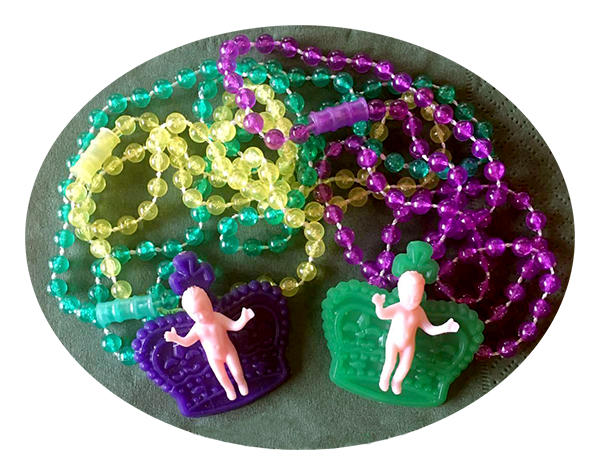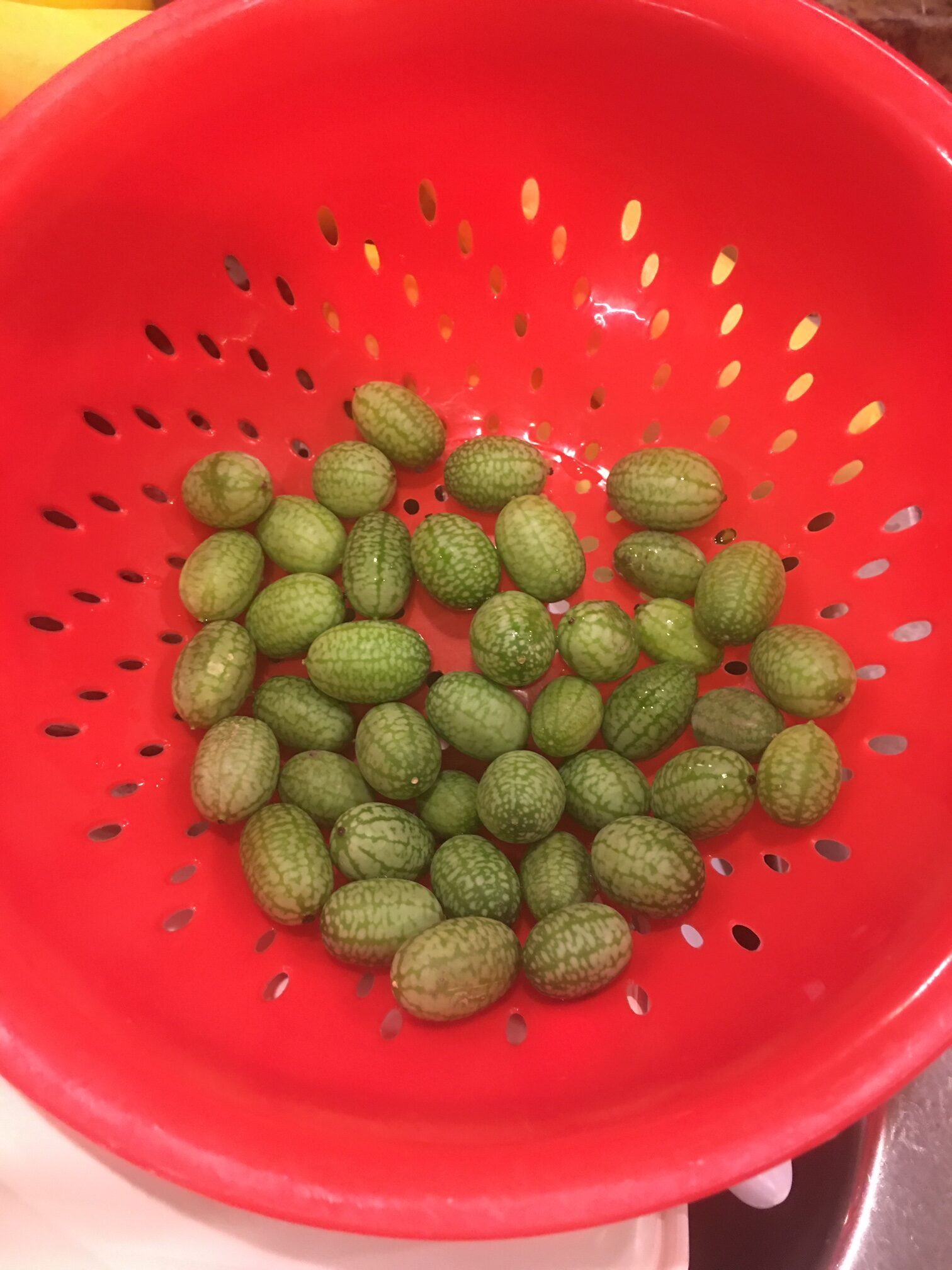Welcome to New Orleans (or New A’wlins, as the locals fondly call it)! With its mix of cultures, ethnicities, and festivals, it’s truly a melange of tastes, smells, and customs. One of the best, in my opinion, is the Mardi Gras, ending on Fat Tuesday, the last day of celebration before the season of Lent begins on Ash Wednesday. This year, things are a bit different due to the pandemic, and many celebrations have been curtailed or nixed for this year. Residents are finding different ways to celebrate and keep their traditions, but one that stands firm is the King Cake.
I could write about King Cakes myself, since I hail from the New Orleans area, where I lived during my childhood and teens, until around age 27. But today, I have a guest author who has agreed to give us her perspective and experiences in this wonderful tradition.

Allow me to introduce Frances Reed, a lifelong resident of New Orleans, and a veteran teacher in the schools there for many, many years. She has memories to share and some fun history and facts about these delicious cakes. Please enjoy!
It’s Carnival Time in New A’wlins!
by Frances Reed
In our city you can often hear, “Laissez les bons temps roulez!” No matter the season, we enjoy letting the good times roll.
Religion is a vital part of the lives of Louisiana people. Our city was founded as a French colony by French Catholic explorers on Mardi Gras day in 1718. As descendants of these Roman Catholics, the lives of the people of New Orleans and southern Louisiana still follow this liturgical calendar.

In other parts of the United States, Christmas is often declared “over” on December 26, but not here. Christmas day 2020 was long-awaited and is now history, and yet we continue to celebrate. We don’t have a Christmas letdown.
We decorated, commemorated, and celebrated during the entire month of December. The New Year arrived with fireworks and the Sugar Bowl and the expectation of another important season. The City that Care Forgot continues to celebrate the season of Christmas in its own unique way. You might hear folks call out in fun:
“Hey, do I hear camels comin’ down the street?”
“Do I see men with crowns in fancy robes?”
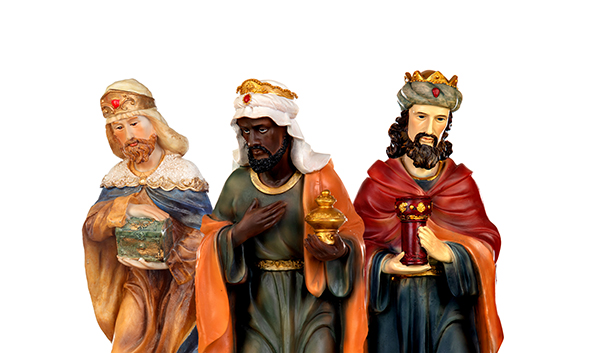
We sure do! On January 6th, we celebrated the 12th day of Christmas. It is called Epiphany or King’s Day, when the Three Wise Men or Magi brought gifts to Baby Jesus. And guess what, we get a gift on that day, too. We celebrate King’s Day with a very special New Orleans tradition. It is the beginning of the Carnival season and we are lined up at our favorite bakery to buy that traditional gift, the king cake.
In our beloved city, traditional religious observance joins and blends with a season of revelry. January 6 gives us all four to six weeks more of celebrating until Mardi Gras Day. It’s Carnival time in New Orleans, when we decorate and celebrate and feast on that traditional symbol of Mardi Gras. This tradition is part of all life in the Crescent City. From individuals to families to businesses to carnival organizations, this symbol marks an important part of our lives.
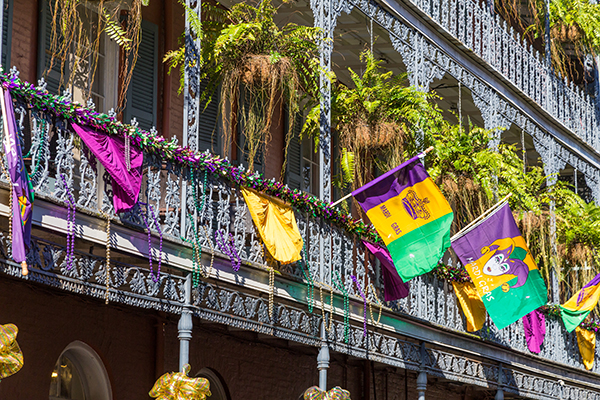
The Twelfth Night Revelers carnival organization gathers to celebrate the beginning of the season and choose their Queen with a golden bean hidden inside a symbolic king cake. Whichever young lady finds the gold bean in her slice of king cake is crowned queen of the Carnival ball.
Where did the king cake come from?
So where did the king cake come from? Carnival season dates back to the Middle Ages. The French Catholics observed the forty days before Ash Wednesday as a time to celebrate before the season of Lent begins. Carnival means “farewell to flesh.” So, the Church wanted to give us a time to party and enjoy meat and milk and good foods before the fasting of Lent.
France wanted to colonize the New World. French explorers led by Jean Baptiste le Moyne, Sieur de Bienville came down the Mississippi River and established the colony of La Nouvelle Orleans in 1718. The French brought their Mari Gras traditions with them. The delicious one that we enjoy during the Carnival season is the king cake.
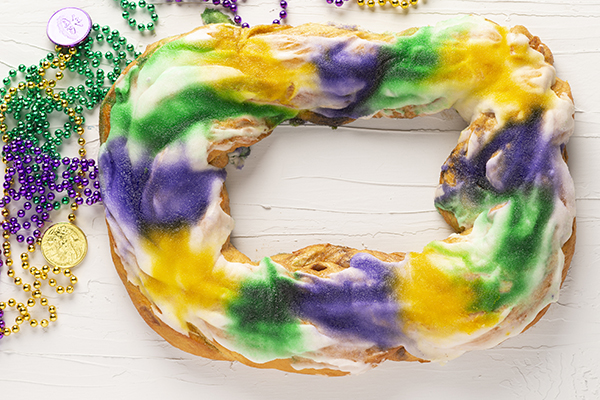
Two types of king cakes!
The French had two different types of king cakes. The one from Northern France is made of flakey, buttery puff pastry with a rum-flavored frangipane (a classic French almond cream filling). We call this French king cake galette de roi, and let me tell you, this puff pastry is absolutely delicious. However, the more traditional king cake that we enjoy in New Orleans is a treat from southern France. It is a traditional cinnamon coffee cake – Danish pastry covered with colored sugar or with both fondant icing and colored sugar. When making the journey to colonize New Orleans, the French Catholics from southern France brought this sweet tradition with them. And, as New Orleans has always been a city of diverse ethnicities, backgrounds, and open arms, people of all religions and backgrounds joined in the fun.
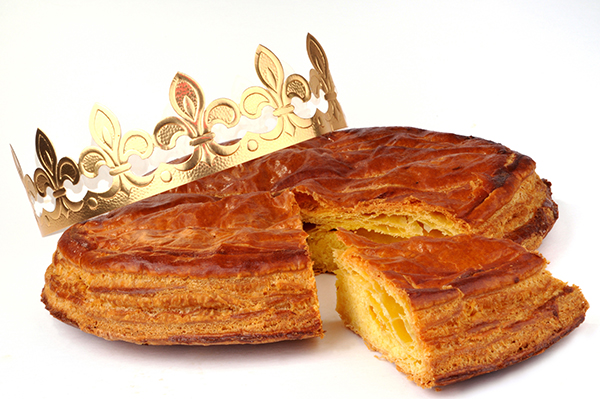
King cake is the most famous dessert of Mardi Gras. By the way, it can be eaten and enjoyed during any time of the day, especially at parades. Every bakery in the greater metropolitan New Orleans area has its own special spin on the tasty tradition which started over 300 years ago. Please believe me when I say bakeries can be highly creative when filling an oval shaped king cake. Why is it oval? In New A’wlins, our king cake is an oval shape to symbolize the unity of faiths. It is a braided, cinnamon coffee cake-pastry decorated with icing and sugars in the official colors of Mardi Gras: purple, which symbolizes justice; green, which symbolizes faith (in God); and gold, which symbolizes power (king/queen). Today king cakes can have a variety of cream custard fillings such as Bavarian cream, chocolate, lemon, or fruit fillings like strawberry, blueberry, cherry, and raspberry. There is even a pecan praline for those who love pralines. Some even have purple, green, and gold sprinkles on the icing. Sounds really good, doesn’t it? Just the sight of one makes you want to go to the nearest bakery. When they were first made and sold in the city by a bakery named McKenzie’s, the king cake was slightly sweetened bread covered with Mardi Gras colored granulated sugar. For many native New Orleanians, this simple king cake is what they remember and love best. Now, however, more choices abound!
Bakeries like Maurice French Pastry, Manny Randazzo, Haydel’s, Gambino’s, Caluda, Nonna Randazzo, and Hi Do Bakery, to name a few, do a booming business during Carnival season. Why? The people of New Orleans love the infinite variety of this sweet New Orleans Mardi Gras tradition. Things have changed a lot since the fifties, but the prize is still that coveted baby.
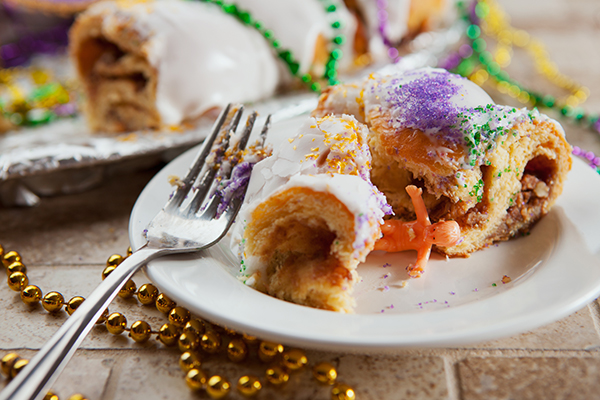
This yummy oval shaped pastry is not just a coffee cake. There is a special surprise hidden inside and this surprise has changed over the years, although the symbolism is the same. Many years ago, there was a coin, gold fava bean, or even a sugared pecan inside. As time went by, the bean was replaced by a small ceramic figurine of baby. Why a baby? That’s the religious connection to our French Catholic founders. The baby symbolizes the baby Jesus who received gifts on Three King’s day and it’s how we pay homage to him. Later the ceramic was replaced by a small one-inch plastic baby. King cake is a special treat shared by family members, friends, classmates, and co-workers. Every Friday is king cake day during the Carnival season.
Mardi Gras Memories
This small plastic baby hidden from sight like Baby Jesus hid from King Herod reminds me of a fond memory from my childhood days during the late fifties. As a New Orleans native living in the city in the 50s I’d like to share this memory that makes me smile. My classmates and I had weekly Carnival costume parties from January 6 to the Friday before Mardi Gras. My whole class would gather at a student’s home to have food, drinks, music for dancing, and a special dessert. But the dessert was served first. It was a large king cake. Everyone would get a slice with the anticipation that inside one of the slices was the hidden baby. We waited for the squeal, “I got the baby!” The person would then be crowned king or queen of the party. The handmade crown was covered with shiny aluminum foil and was treasured as if it was solid silver. The person would then choose a partner to be his/her royal partner. The person who got the baby would follow Carnival tradition by hosting the next party.
Another Carnival memory that makes me smile is from the time I spent as a teacher. Fridays in Carnival season were King Cake Friday. One student would volunteer to bring the first king cake. The cake was served, and whichever classmate got the baby, that person would bring the king cake the following week. The class would love the date of Mardi Gras (a moveable holiday) to arrive late in February because that meant more Fridays for king cake. Many schools would have a school yard parade for the younger students. After the parade, there would be a huge king cake party in the cafeteria.
I’m sure if adults look around their offices, they’ll find that someone brings a king cake on Friday for everyone to enjoy. You never outgrow the need for king cake.
Once upon a time, the treasured plastic baby was hidden by bakery workers in a king cake. The mystery of its location could only be solved by cutting the cake into generous slices and serving it to family and friends waiting for the shout, “I got the baby! But as we had many visitors come to share Mardi Gras, there became a safety concern. Whereas NOLA natives knew there was a hidden baby in the king cake, the tourists did not know this, and some were eating or choking on it. And so, a new tradition began. The baby was wrapped in a small plastic bag with instructions to hide the baby in the king cake before serving and tell those about to enjoy it to be on the lookout for the baby.
Would you like to try King Cake?
As New Orleans natives have traveled and settled in many areas of the country, they brought the demand for king cake with them. How can they get a king cake where they live? Well, they can come home for a visit to see their family, or order one. And so can you – online ordering has flourished as the demand grew for this traditional Carnival favorite. Bakeries in New Orleans make over 750,000 king cakes for the city each year and would love to ship them anywhere in the country that you live. It’s possible in some areas to purchase king cakes locally – but it’s hard to beat the original New Orleans king cake!
Can’t decide which one to get? Do a comparison shop at the King Cake Hub in the city. It carries all that are made in the greater metro area of New Orleans from the city to Metairie, to Chalmette to North Shore communities of Covington, Mandeville, and Slidell. Once you have had this New Orleans treat, you will be back in line to order another. They are that good and that amazingly delicious. The City that Care Forgot never forgets to care about the traditions that mean the most to us, especially the Mardi Gras king cake.
And so, mes amis, (my friends), laissez les bons temps roulez! (let the good times roll!) Have a slice of king cake. You might just get the baby!
A few final comments from your blog host
Hi everyone, it’s Carol here again – wasn’t that great? Makes me want to order one NOW – they are so good. A big thanks to Frances Reed for sharing her memories and story with us! The story behind the King Cake tradition is one of the things that is integral to New Orleans life and culture. I’m a displaced New Orleanian (really a displaced Louisianian), but I do love my new home state of Texas. Fortunately, we have a few good King Cakes over here in Texas so maybe I will get one on order – or perhaps a galette des rois! Good food and great customs help us make our lives full and joyful! Join me in journaling your journey, and watch for a photo gallery of king cakes, including some from the great New Orleans bakeries mentioned in the article, coming soon.
I’ll also be posting a recipe for a basic King Cake, and my special King Cake bread pudding recipe. Watch for them, coming very, very soon!
